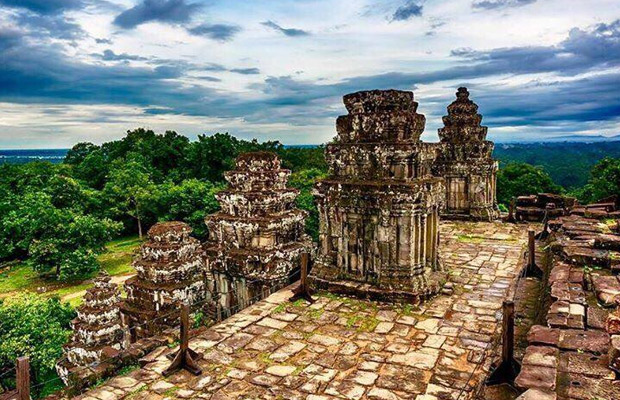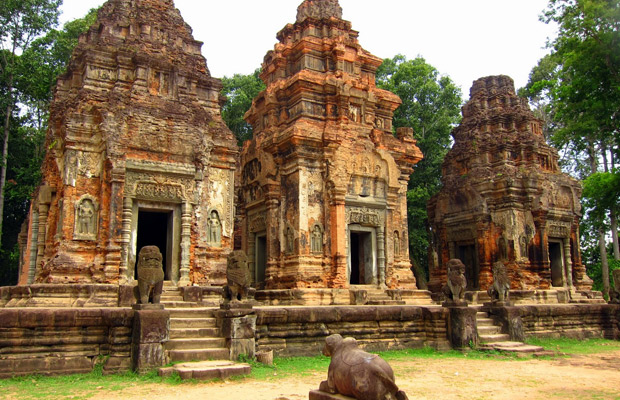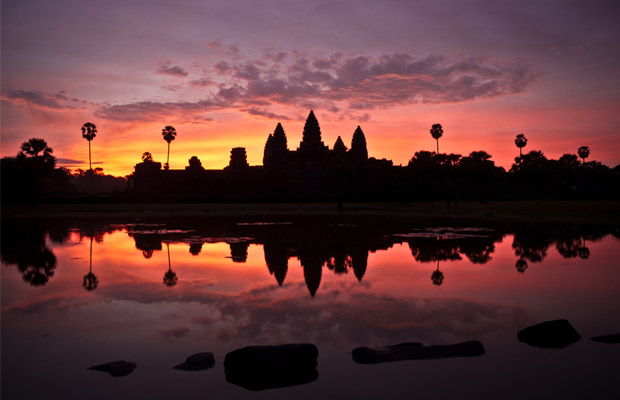Lolei Temple
Lolei (Khmer: ប្រាសាទលលៃ) is the northernmost temple of the Roluos group of three Hindu temples from the late 9th century in Angkor, Cambodia, whose other members are Preah Ko and Bakong. Lolei was the last of the three temples to be built as part of the city of Hariharalaya which once flourished in Roluos, and in 893 the king xerão Yasovarman I dedicate to Shiva and the members of the royal family.
Lolei (Khmer: ប្រាសាទលលៃ) is the northernmost temple of the Roluos group of three Hindu temples from the late 9th century in Angkor, Cambodia, whose other members are Preah Ko and Bakong. Lolei was the last of the three temples to be built as part of the city of Hariharalaya which once flourished in Roluos, and in 893 the king xerão Yasovarman I dedicate to Shiva and the members of the royal family. The name "Lolei" is thought to be a modern corruption of the old name "Hariharalaya" [1]: 98,112 which means "the city of Hariara". Once an island temple, Lolei was located on an island slightly north of the center, in the now-dried Indratataka deck, [2]: 60 buildings that had been completed under the father of Yasovarman and predecessor Indravarman I. Scholars believe which placed the temple in an island in the middle of a body of water served to symbolically identify it with Mount Meru, home of the gods, which in Hindu mythology is surrounded by the world's oceans.
Local
This sandstone carved in Lolei shows a fanged dvarapala armed with a trident standing in an arched doorway. At the level of the elbows, two makara heads are facing outwards.
Lolei is composed of four tower towers grouped on a terrace. The king builds Lolei for his ancestors. One for the grandfather, one for the grandmother, one for the father and one for the mother. The front two towers are for the males, while the two towers on the back are for the females. The two tallest towers are for their grandparents, while the two shorter towers are for their parents. Originally, the towers were closed by an external wall access through which it was through a gopura, but neither wall nor gopura survived the present. Today, the temple is next to a monastery, just as in the 9th century it was next to an ashrama.
The temple towers are known for their decorative elements, including their false doors, their carved lintels and their carved devatas and dvarapalas that flank real and false doors. Some of the motifs represented in the lintels and other sandstone sculptures are the sky god Indra, mounted on the Airavata elephant, serpent monsters such as makaras and multiple-headed nagas.
View Mores Temple Guide

Kbal Spean
Kbal Spean is an archaeological site of the Angkorian era on the southwest slopes of the Kulen Hills, northeast of Angkor, in the Siem Reap district of Siem Reap province, Cambodia. It is situated ...

Bakong Temple
Bakong (Khmer: ប្រាសាទបាគង) is the first mountain of the sandstone temple built by the rulers of the Khmer empire in Angkor, near modern Siem Reap in Cambodia. In the last ...

Ta Som
Ta Som is a small temple in Angkor, Cambodia, built at the end of the 12th century for King Jayavarman VII. It is located northeast of Angkor Thom and east of Neak Pean. The King dedicated the temple ...

Phnom Bakheng
Phnom Bakheng in Angkor, Cambodia, is a Hindu and Buddhist temple in the shape of a temple mountain. Dedicated to Shiva, it was built at the end of the 9th century, during the reign of King ...

Angkor Thom West Gate
The sidewalk at the west gate of Angkor Thom collapsed completely, leaving a heap of ancient stones coming out of the ground like victims of a terrible historical ...

Prasat Aur Pha On
The Orpong temple is one of the other temples in the Kulen mountains, such as Prasith Damrey Krab, Tzu Chi Chinese, etc., built on the throne of Jayavarman II. The temples are mostly built of ...

Phnom Bok
Phnom Bok (Khmer: ភ្នំ បូក) is a hill in the northeast east of Baray in Cambodia, with a prasat (Khmer: ប្រាសាទភ្នំបូក) of the same name built on it. It is ...

Preah Pithu
Preah Pithu (Khmer: ប្រាសាទព្រះពិធូរ), or Prasat Preah Pithu, is a group of five temples in Angkor, Cambodia. In fact, they probably were not designed as a group. ...

Phnom Krom
Phnom Krom (Khmer: ភ្នំ ក្រោម) is a 140 m high hill near the town of Siem Reap in Cambodia and there is a temple located at the top that derived its name from the hill, "Prasat ...

Phnom Kulen Linga River
The 1,000-lingual river owes its name to the images of Hindu gods, their spouses and more than 1,000 slings carved into the bed and banks of the Siem Reap River in Phnom Kulen. The lanyards are a ...

Mechrey Floating Village
Siem Reap is famous for not only the ancient Khmer temples, but also the unique floating villages on the bank of Tonle Sap, situated 9 kilometers west of Siem Reap. One of the three largest villages ...

Preah Ko Temple
Preah Ko (Khmer: The Sagred Bull) was the first temple to be built in the ancient and now extinct city of Hariharalaya (in the area now called Roluos), about 15 kilometers southeast of the main Group ...












